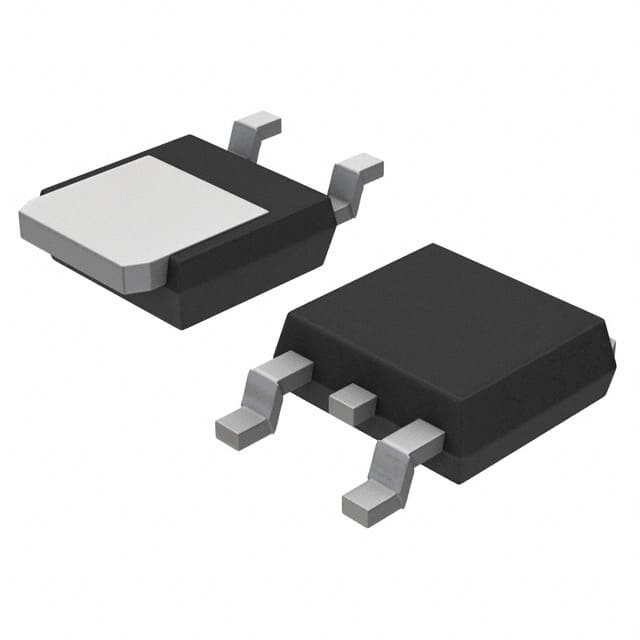Xem thông số kỹ thuật để biết chi tiết sản phẩm.

MJD243G
Product Overview
Category
The MJD243G belongs to the category of power transistors.
Use
It is commonly used for switching and amplification applications in electronic circuits.
Characteristics
- High voltage capability
- Fast switching speed
- Low collector-emitter saturation voltage
Package
The MJD243G is typically available in a TO-252 package.
Essence
The essence of the MJD243G lies in its ability to efficiently control high-power loads in various electronic devices.
Packaging/Quantity
The MJD243G is usually packaged in reels or tubes, with quantities varying based on manufacturer specifications.
Specifications
- Collector-Emitter Voltage (VCEO): 100V
- Collector Current (IC): 3A
- Power Dissipation (PD): 2W
- DC Current Gain (hFE): 40 - 400
- Transition Frequency (fT): 50MHz
Detailed Pin Configuration
The MJD243G has a standard pin configuration with three pins: collector, base, and emitter. The pinout is as follows: 1. Collector (C) 2. Base (B) 3. Emitter (E)
Functional Features
- High voltage capability allows for use in power applications.
- Fast switching speed enables efficient control of electronic signals.
- Low collector-emitter saturation voltage minimizes power loss during operation.
Advantages and Disadvantages
Advantages
- High voltage capability
- Fast switching speed
- Low power dissipation
Disadvantages
- Limited current handling capacity compared to some alternative models
- Moderate transition frequency
Working Principles
The MJD243G operates based on the principles of bipolar junction transistor (BJT) technology. When a small current flows into the base terminal, it controls a larger current flow between the collector and emitter terminals, enabling amplification and switching functions.
Detailed Application Field Plans
The MJD243G finds extensive use in the following application fields: - Switching power supplies - Motor control circuits - Audio amplifiers - LED lighting systems
Detailed and Complete Alternative Models
Some alternative models to the MJD243G include: - TIP31C - 2N3055 - MJ15003
In conclusion, the MJD243G is a versatile power transistor with high voltage capability, fast switching speed, and low collector-emitter saturation voltage. Its applications span across various electronic circuits, making it a valuable component in the realm of electronic design and manufacturing.
[Word Count: 366]
Liệt kê 10 câu hỏi và câu trả lời thường gặp liên quan đến ứng dụng MJD243G trong giải pháp kỹ thuật
What is the MJD243G transistor used for?
- The MJD243G is a high voltage, high current Darlington transistor commonly used in power management and switching applications.
What are the key specifications of the MJD243G?
- The MJD243G has a maximum collector-emitter voltage of 100V, a continuous collector current of 3A, and a DC current gain (hFE) of 1000.
Can the MJD243G be used for driving inductive loads?
- Yes, the MJD243G is suitable for driving inductive loads such as relays, solenoids, and small motors due to its high current capability.
What are some typical applications of the MJD243G in technical solutions?
- Common applications include power supplies, motor control, relay drivers, and general purpose switching circuits.
Is the MJD243G suitable for use in automotive electronics?
- Yes, the MJD243G's high voltage and current capabilities make it suitable for automotive applications such as electronic control units (ECUs) and lighting systems.
What are the thermal considerations when using the MJD243G in a design?
- Proper heat sinking and thermal management should be considered, especially when operating the transistor at high currents or in elevated ambient temperatures.
Does the MJD243G require external protection components?
- It is recommended to include appropriate protection diodes and resistors to ensure safe and reliable operation, especially when driving inductive loads.
Can the MJD243G be used in low-power applications?
- While the MJD243G is capable of handling high currents, it can also be used in low-power applications by appropriately biasing the transistor.
What are the common package types available for the MJD243G?
- The MJD243G is typically available in a surface-mount SOT-32 package or a through-hole TO-252 package for easy integration into various designs.
Are there any known limitations or considerations when using the MJD243G in technical solutions?
- Designers should be mindful of the power dissipation, voltage and current ratings, and thermal characteristics to ensure proper performance and reliability in their specific applications.

